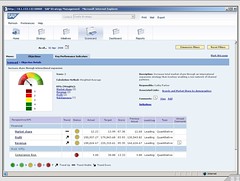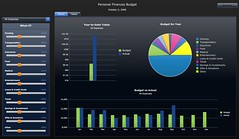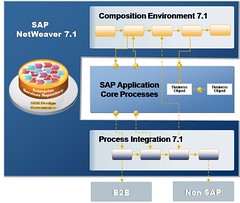Wolfgang Hilpert, SVP of BPM for SAP, must be tired of seeing my face by now: an accidental lunch encounter and an interview yesterday, his session at the NetWeaver theater this morning, and I ended my day with his panel on SAP and BPM that also included Benjamin Salter of Valero Energy, Janelle Hill of Gartner, Mandar Nagle of Accenture and Peter Graf of SAP, moderated by Harald Nehring of SAP.
The panel started with a short bit by Hill on the BPM marketplace and how it’s driven by the search for operational excellence. She showed the current hype cycle that has business process platforms just at the technology trigger stage, BPM as a discipline about halfway up the slope towards the peak of inflated expectations, BPMS approaching the top of that peak and BPM pure-play tools just crawling out of the trough of disillusionment towards the slope of enlightenment. She also talked to their projections of BPMS market size, which still uses a 2006 actual figure of $1.7B to project $5.6B by 2011. Given the entry of SAP into this marketplace, we’ll start to see growth that may actually approach this, although I think that this is still a bit aggressive.
It then moved into more of a panel format, with Nehring asking questions of the panelists, starting with Graf talking about how SAP has always been process-oriented (true, although those processes were embedded opaquely in their core applications and could only be changed through coding), and the value of composing processes from services.
Salter’s company has been an influencer during the development of NetWeaver BPM. They’ve grown rapidly through mergers and acquisitions, which has resulted in a patchwork of systems held together with duct tape and string. They’re using BPM to bring discipline into their integration techniques, although it’s not clear that they’ve actually done much to date: he talked about their first BPM process in the future tense. It sounds like a good test case for BPM, covering product quality testing including both automated collation/analysis of test results and human approval steps.
Hlilpert walked us through the process of designing the BPM product over the past two years, and how both ecosystem partners and customers have been involved through much of the process in order to make the product as functional and usable as possible. He also mentioned the how they’re starting to work with the Business Objects team to really bring together BPM, BRM and BI and build actionable process analytics.
Hill sees SAP as being in a position to leapfrog IBM and Oracle in the platform vendor end of the BPM market, and feels that they have more of the tools that will allow customers to actually close the gap between strategy and execution in terms of operational excellence. This is a significant statement to hear from a Gartner analyst in the wild.
There was a discussion about standards (my favourite topic 🙂 ): the chief architect on the SAP BPM team is on the OMG BPMN 2.0 standards committee, including the efforts to include a serialization format, but Hill pointed out that standards are “just specifications” and all vendors have their own particular flavour of standards, making interoperability more of a philosophy than a reality. She sees BPMN as a notational standard to be valuable so that everyone can visually understand the same diagrams the same way, but seemed to imply that not a lot of people were actually moving the process models from one tool to another — something that I’ve also seen in practice. Salter said that his business analysts really like BPMN because it’s so much more business-friendly than UML use cases, and agree that the visual notation has been key for them.
Before Nehring opened up the panel to audience questions, he said that he has read that “BPM is the killer app for SOA” and asked for the panel’s opinion on that; I almost laughed out loud at that one, since Ismael Ghalimi wrote that a couple of years ago, and I’ve unabashedly stolen it in several presentations and blog posts that I’ve done (crediting Ismael, of course).
The question came up about using IDS Scheer for process modeling versus using NetWeaver BPM; Graf made a fuzzy non-statement that “this does not mean the end of the relationship” and that “standards will strengthen the link between the tools”. Having had to deal with a flurry of communications from IDS Scheer’s PR this morning about my comments on this yesterday — who, like many other vendors, refuse to post a comment on the blog post but prefer to lobby me to change the post — I’ll just point out how customers of other (non-SAP) BPMS products use those products with ARIS: they do their enterprise modeling in ARIS, including some level of business processes, then may or may not have a method for transferring those process models directly from ARIS to their BPMS, depending on the support for specific standards and other interchange formats.
With a conference of this size, SAP can arrange a pretty awesome “conference night out” for us: we’re all going to see Eric Clapton tonight. I’ll be back for a couple of BPM sessions in the morning; the conference finishes midday and I’ll be home in time for the last two hours of my other half’s birthday tomorrow night.




